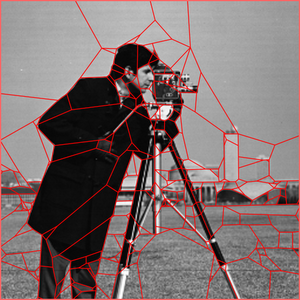Information
- Publication Type: Journal Paper with Conference Talk
- Workgroup(s)/Project(s):
- Date: December 2016
- Journal: Lecture Notes in Computer Science (LNCS)
- Volume: 10072
- Location: Las Vegas
- Lecturer: Jeremy Forsythe
- ISSN: 0302-9743
- Event: ISVC 2016
- Conference date: 12. December 2016 – 14. December 2016
- Pages: 223 – 233
- Keywords: superpixels, polygonal mesh, Delaunay triangulation, constrained triangulation, edge detection
Abstract
The over-segmentation problem for images is studied in the new resolution-independent formulation when a large image is approximated by a small number of convex polygons with straight edges at subpixel precision. These polygonal superpixels are obtained by refining and extending subpixel edge segments to a full mesh of convex polygons without small angles and with approximation guarantees. Another novelty is the objective error difference between an original pixel-based image and the reconstructed image with a best constant color over each superpixel, which does not need human segmentations. The experiments on images from the Berkeley Segmentation Database show that new meshes are smaller and provide better approximations than the state-of-the-art.Additional Files and Images
Weblinks
No further information available.BibTeX
@article{forsythe-2016-ccm,
title = "Resolution-independent superpixels based on convex
constrained meshes without small angles",
author = "Jeremy Forsythe and Vitaliy Kurlin and Andrew Fitzgibbon",
year = "2016",
abstract = "The over-segmentation problem for images is studied in the
new resolution-independent formulation when a large image is
approximated by a small number of convex polygons with
straight edges at subpixel precision. These polygonal
superpixels are obtained by refining and extending subpixel
edge segments to a full mesh of convex polygons without
small angles and with approximation guarantees. Another
novelty is the objective error difference between an
original pixel-based image and the reconstructed image with
a best constant color over each superpixel, which does not
need human segmentations. The experiments on images from the
Berkeley Segmentation Database show that new meshes are
smaller and provide better approximations than the
state-of-the-art.",
month = dec,
journal = "Lecture Notes in Computer Science (LNCS)",
volume = "10072",
issn = "0302-9743",
pages = "223--233",
keywords = "superpixels, polygonal mesh, Delaunay triangulation,
constrained triangulation, edge detection",
URL = "https://www.cg.tuwien.ac.at/research/publications/2016/forsythe-2016-ccm/",
}

 paper
paper
